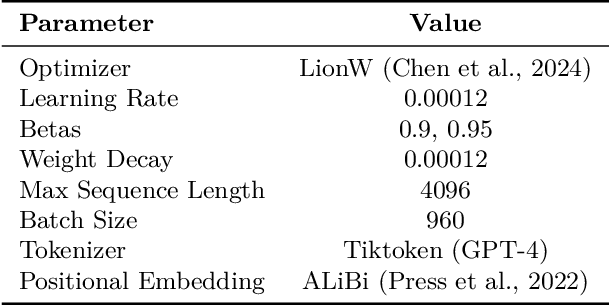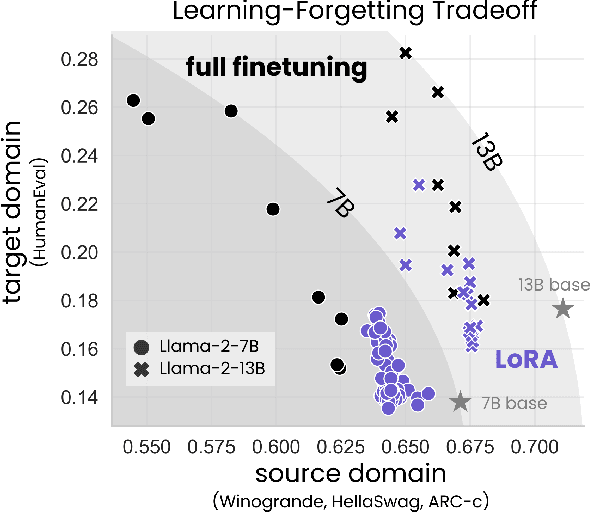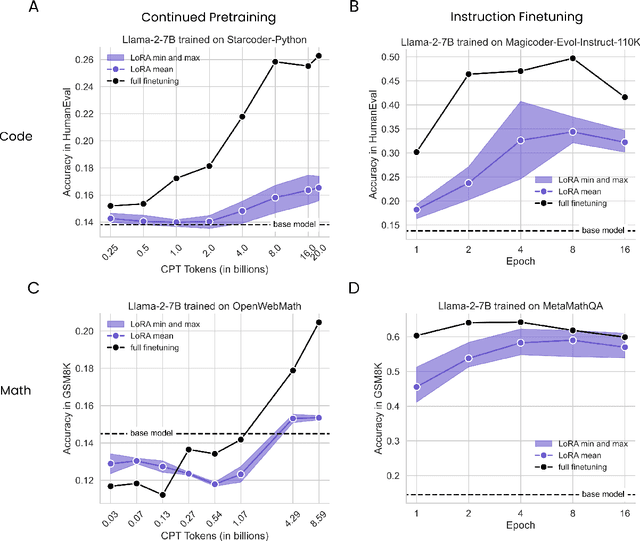Mansheej Paul
$μ$nit Scaling: Simple and Scalable FP8 LLM Training
Feb 09, 2025Abstract:Large Language Model training with 8-bit floating point (FP8) formats promises significant efficiency improvements, but reduced numerical precision makes training challenging. It is currently possible to train in FP8 only if one is willing to tune various hyperparameters, reduce model scale, or accept the overhead of computing dynamic scale factors. We demonstrate simple, scalable FP8 training that requires no dynamic scaling factors or special hyperparameters, even at large model sizes. Our method, $\mu$nit Scaling ($\mu$S), also enables simple hyperparameter transfer across model widths, matched numerics across training and inference, and other desirable properties. $\mu$nit Scaling is straightforward to implement, consisting of a set of minimal interventions based on a first-principles analysis of common transformer operations. We validate our method by training models from 1B to 13B parameters, performing all hidden linear layer computations in FP8. We achieve quality equal to higher precision baselines while also training up to 33% faster.
Soup to go: mitigating forgetting during continual learning with model averaging
Jan 09, 2025Abstract:In continual learning, where task data arrives in a sequence, fine-tuning on later tasks will often lead to performance degradation on earlier tasks. This is especially pronounced when these tasks come from diverse domains. In this setting, how can we mitigate catastrophic forgetting of earlier tasks and retain what the model has learned with minimal computational expenses? Inspired by other merging methods, and L2-regression, we propose Sequential Fine-tuning with Averaging (SFA), a method that merges currently training models with earlier checkpoints during the course of training. SOTA approaches typically maintain a data buffer of past tasks or impose a penalty at each gradient step. In contrast, our method achieves comparable results without the need to store past data, or multiple copies of parameters for each gradient step. Furthermore, our method outperforms common merging techniques such as Task Arithmetic, TIES Merging, and WiSE-FT, as well as other penalty methods like L2 and Elastic Weight Consolidation. In turn, our method offers insight into the benefits of merging partially-trained models during training across both image and language domains.
Scaling Laws for Precision
Nov 07, 2024Abstract:Low precision training and inference affect both the quality and cost of language models, but current scaling laws do not account for this. In this work, we devise "precision-aware" scaling laws for both training and inference. We propose that training in lower precision reduces the model's "effective parameter count," allowing us to predict the additional loss incurred from training in low precision and post-train quantization. For inference, we find that the degradation introduced by post-training quantization increases as models are trained on more data, eventually making additional pretraining data actively harmful. For training, our scaling laws allow us to predict the loss of a model with different parts in different precisions, and suggest that training larger models in lower precision may be compute optimal. We unify the scaling laws for post and pretraining quantization to arrive at a single functional form that predicts degradation from training and inference in varied precisions. We fit on over 465 pretraining runs and validate our predictions on model sizes up to 1.7B parameters trained on up to 26B tokens.
Critique-out-Loud Reward Models
Aug 21, 2024Abstract:Traditionally, reward models used for reinforcement learning from human feedback (RLHF) are trained to directly predict preference scores without leveraging the generation capabilities of the underlying large language model (LLM). This limits the capabilities of reward models as they must reason implicitly about the quality of a response, i.e., preference modeling must be performed in a single forward pass through the model. To enable reward models to reason explicitly about the quality of a response, we introduce Critique-out-Loud (CLoud) reward models. CLoud reward models operate by first generating a natural language critique of the assistant's response that is then used to predict a scalar reward for the quality of the response. We demonstrate the success of CLoud reward models for both Llama-3-8B and 70B base models: compared to classic reward models CLoud reward models improve pairwise preference classification accuracy on RewardBench by 4.65 and 5.84 percentage points for the 8B and 70B base models respectively. Furthermore, CLoud reward models lead to a Pareto improvement for win rate on ArenaHard when used as the scoring model for Best-of-N. Finally, we explore how to exploit the dynamic inference compute capabilities of CLoud reward models by performing self-consistency decoding for reward prediction.
Does your data spark joy? Performance gains from domain upsampling at the end of training
Jun 05, 2024



Abstract:Pretraining datasets for large language models (LLMs) have grown to trillions of tokens composed of large amounts of CommonCrawl (CC) web scrape along with smaller, domain-specific datasets. It is expensive to understand the impact of these domain-specific datasets on model capabilities as training at large FLOP scales is required to reveal significant changes to difficult and emergent benchmarks. Given the increasing cost of experimenting with pretraining data, how does one determine the optimal balance between the diversity in general web scrapes and the information density of domain specific data? In this work, we show how to leverage the smaller domain specific datasets by upsampling them relative to CC at the end of training to drive performance improvements on difficult benchmarks. This simple technique allows us to improve up to 6.90 pp on MMLU, 8.26 pp on GSM8K, and 6.17 pp on HumanEval relative to the base data mix for a 7B model trained for 1 trillion (T) tokens, thus rivaling Llama-2 (7B)$\unicode{x2014}$a model trained for twice as long. We experiment with ablating the duration of domain upsampling from 5% to 30% of training and find that 10% to 20% percent is optimal for navigating the tradeoff between general language modeling capabilities and targeted benchmarks. We also use domain upsampling to characterize at scale the utility of individual datasets for improving various benchmarks by removing them during this final phase of training. This tool opens up the ability to experiment with the impact of different pretraining datasets at scale, but at an order of magnitude lower cost compared to full pretraining runs.
Perplexed by Perplexity: Perplexity-Based Data Pruning With Small Reference Models
May 30, 2024Abstract:In this work, we investigate whether small language models can determine high-quality subsets of large-scale text datasets that improve the performance of larger language models. While existing work has shown that pruning based on the perplexity of a larger model can yield high-quality data, we investigate whether smaller models can be used for perplexity-based pruning and how pruning is affected by the domain composition of the data being pruned. We demonstrate that for multiple dataset compositions, perplexity-based pruning of pretraining data can \emph{significantly} improve downstream task performance: pruning based on perplexities computed with a 125 million parameter model improves the average performance on downstream tasks of a 3 billion parameter model by up to 2.04 and achieves up to a $1.45\times$ reduction in pretraining steps to reach commensurate baseline performance. Furthermore, we demonstrate that such perplexity-based data pruning also yields downstream performance gains in the over-trained and data-constrained regimes.
LoRA Learns Less and Forgets Less
May 15, 2024



Abstract:Low-Rank Adaptation (LoRA) is a widely-used parameter-efficient finetuning method for large language models. LoRA saves memory by training only low rank perturbations to selected weight matrices. In this work, we compare the performance of LoRA and full finetuning on two target domains, programming and mathematics. We consider both the instruction finetuning ($\approx$100K prompt-response pairs) and continued pretraining ($\approx$10B unstructured tokens) data regimes. Our results show that, in most settings, LoRA substantially underperforms full finetuning. Nevertheless, LoRA exhibits a desirable form of regularization: it better maintains the base model's performance on tasks outside the target domain. We show that LoRA provides stronger regularization compared to common techniques such as weight decay and dropout; it also helps maintain more diverse generations. We show that full finetuning learns perturbations with a rank that is 10-100X greater than typical LoRA configurations, possibly explaining some of the reported gaps. We conclude by proposing best practices for finetuning with LoRA.
Pretraining task diversity and the emergence of non-Bayesian in-context learning for regression
Jun 26, 2023Abstract:Pretrained transformers exhibit the remarkable ability of in-context learning (ICL): they can learn tasks from just a few examples provided in the prompt without updating any weights. This raises a foundational question: can ICL solve fundamentally $\textit{new}$ tasks that are very different from those seen during pretraining? To probe this question, we examine ICL's performance on linear regression while varying the diversity of tasks in the pretraining dataset. We empirically demonstrate a $\textit{task diversity threshold}$ for the emergence of ICL. Below this threshold, the pretrained transformer cannot solve unseen regression tasks as it behaves like a Bayesian estimator with the $\textit{non-diverse pretraining task distribution}$ as the prior. Beyond this threshold, the transformer significantly outperforms this estimator; its behavior aligns with that of ridge regression, corresponding to a Gaussian prior over $\textit{all tasks}$, including those not seen during pretraining. These results highlight that, when pretrained on data with task diversity greater than the threshold, transformers $\textit{can}$ solve fundamentally new tasks in-context. Importantly, this capability hinges on it deviating from the Bayes optimal estimator with the pretraining distribution as the prior. This study underscores, in a concrete example, the critical role of task diversity, alongside data and model scale, in the emergence of ICL. Code is available at https://github.com/mansheej/icl-task-diversity.
Unmasking the Lottery Ticket Hypothesis: What's Encoded in a Winning Ticket's Mask?
Oct 06, 2022



Abstract:Modern deep learning involves training costly, highly overparameterized networks, thus motivating the search for sparser networks that can still be trained to the same accuracy as the full network (i.e. matching). Iterative magnitude pruning (IMP) is a state of the art algorithm that can find such highly sparse matching subnetworks, known as winning tickets. IMP operates by iterative cycles of training, masking smallest magnitude weights, rewinding back to an early training point, and repeating. Despite its simplicity, the underlying principles for when and how IMP finds winning tickets remain elusive. In particular, what useful information does an IMP mask found at the end of training convey to a rewound network near the beginning of training? How does SGD allow the network to extract this information? And why is iterative pruning needed? We develop answers in terms of the geometry of the error landscape. First, we find that$\unicode{x2014}$at higher sparsities$\unicode{x2014}$pairs of pruned networks at successive pruning iterations are connected by a linear path with zero error barrier if and only if they are matching. This indicates that masks found at the end of training convey the identity of an axial subspace that intersects a desired linearly connected mode of a matching sublevel set. Second, we show SGD can exploit this information due to a strong form of robustness: it can return to this mode despite strong perturbations early in training. Third, we show how the flatness of the error landscape at the end of training determines a limit on the fraction of weights that can be pruned at each iteration of IMP. Finally, we show that the role of retraining in IMP is to find a network with new small weights to prune. Overall, these results make progress toward demystifying the existence of winning tickets by revealing the fundamental role of error landscape geometry.
Lottery Tickets on a Data Diet: Finding Initializations with Sparse Trainable Networks
Jun 02, 2022



Abstract:A striking observation about iterative magnitude pruning (IMP; Frankle et al. 2020) is that $\unicode{x2014}$ after just a few hundred steps of dense training $\unicode{x2014}$ the method can find a sparse sub-network that can be trained to the same accuracy as the dense network. However, the same does not hold at step 0, i.e. random initialization. In this work, we seek to understand how this early phase of pre-training leads to a good initialization for IMP both through the lens of the data distribution and the loss landscape geometry. Empirically we observe that, holding the number of pre-training iterations constant, training on a small fraction of (randomly chosen) data suffices to obtain an equally good initialization for IMP. We additionally observe that by pre-training only on "easy" training data, we can decrease the number of steps necessary to find a good initialization for IMP compared to training on the full dataset or a randomly chosen subset. Finally, we identify novel properties of the loss landscape of dense networks that are predictive of IMP performance, showing in particular that more examples being linearly mode connected in the dense network correlates well with good initializations for IMP. Combined, these results provide new insight into the role played by the early phase training in IMP.
 Add to Chrome
Add to Chrome Add to Firefox
Add to Firefox Add to Edge
Add to Edge